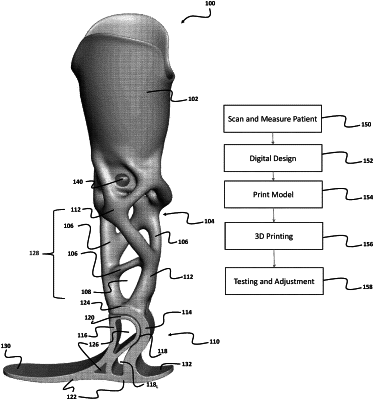| CPC A61F 2/60 (2013.01) [A61F 2/5046 (2013.01); A61F 2/6607 (2013.01); A61F 2/80 (2013.01); B33Y 50/00 (2014.12); B33Y 80/00 (2014.12); A61F 2002/505 (2013.01); A61F 2002/607 (2013.01); A61F 2002/6621 (2013.01); A61F 2002/6642 (2013.01); A61F 2002/6685 (2013.01)] | 2 Claims |

|
1. A patient specific workflow method for producing a unibody transtibial prosthetic device, the workflow comprising:
acquiring patient data via imaging and/or scanning;
constructing a three-dimensional (3D) model from the patient data;
translating the 3D model to a 3D printable design of a unibody transtibial prosthesis;
3D printing the unibody transtibial prosthesis;
wherein the acquiring patient data comprises imaging a contralateral limb and a residual limb;
wherein the imaging is conducted with a smart phone;
wherein the 3D printing prints a unitary socket, pylon and foot and ankle, the pylon has an open structure of interconnected elongated supports having open spaces therebetween and the foot has a split ankle, a split toe and a split heel; and
wherein the 3D printing is a multi-material printing process that forms regions of different stiffnesses in the unitary socket, pylon and foot and ankle.
|